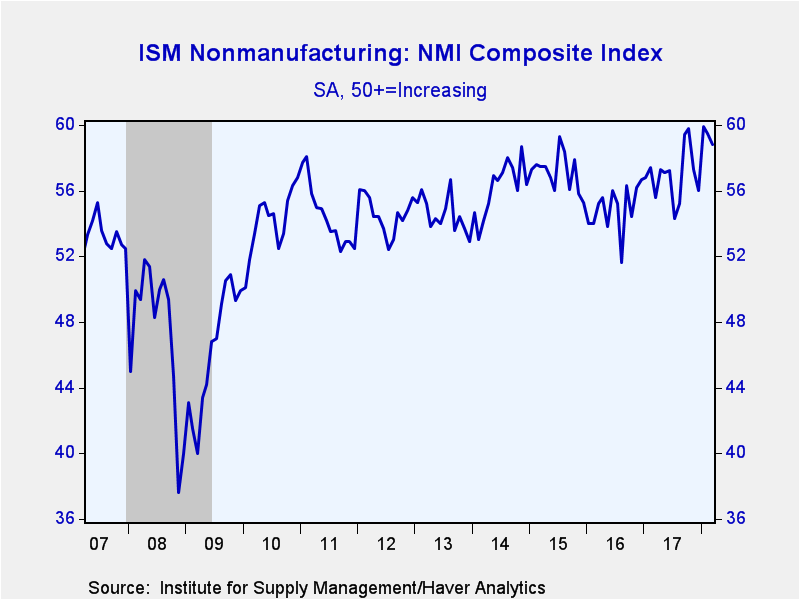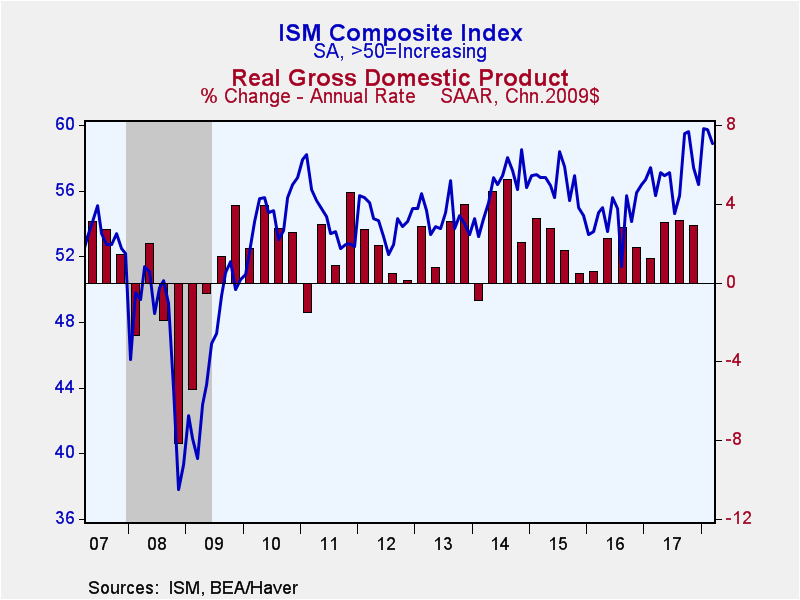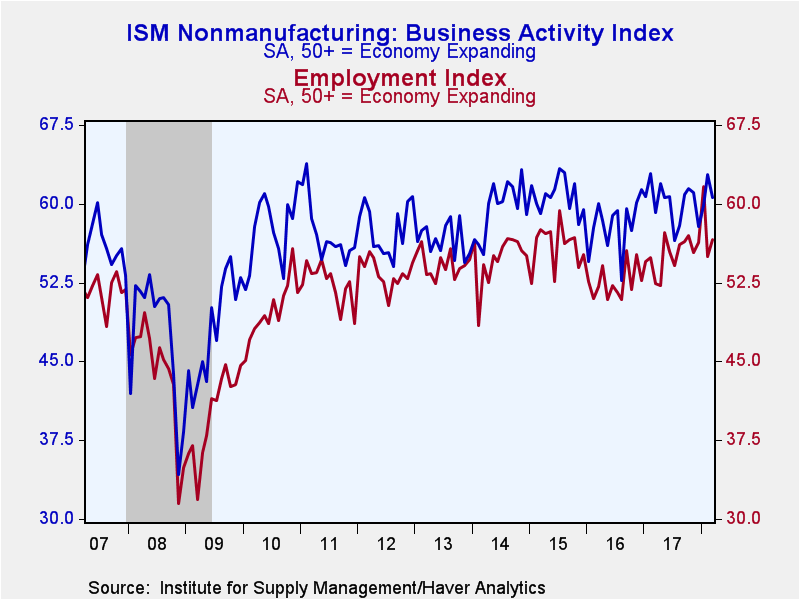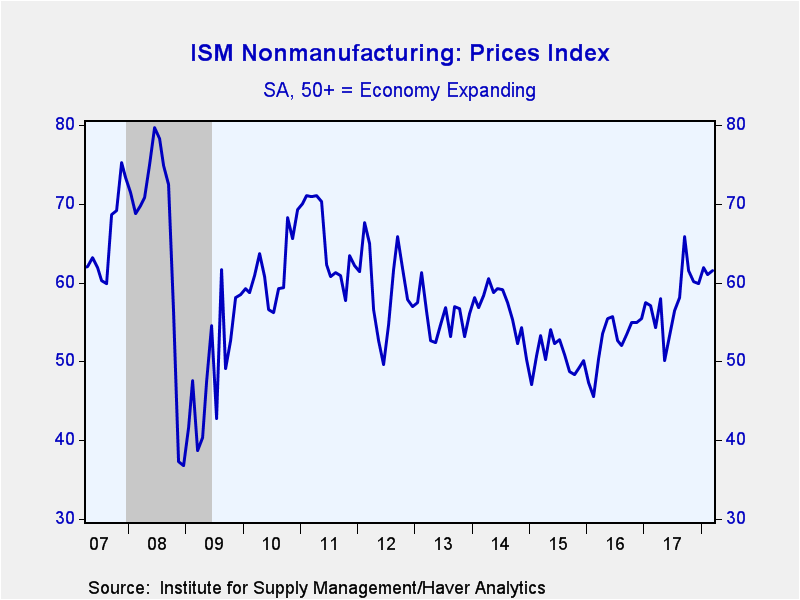 Global| Apr 04 2018
Global| Apr 04 2018U.S. ISM Nonmanufacturing Expansion Slows
by:Tom Moeller
|in:Economy in Brief
Summary
Business activity in the service sector moderated last month. The Composite Index of Nonmanufacturing Sector Activity from the Institute for Supply Management (ISM) slipped to 58.8 during March from an unrevised 59.5 in February. It [...]
Business activity in the service sector moderated last month. The Composite Index of Nonmanufacturing Sector Activity from the Institute for Supply Management (ISM) slipped to 58.8 during March from an unrevised 59.5 in February. It remained up sharply versus the August 2016 low of 51.6. The Action Economics Forecast Survey expected an easing to 59.0. The ISM data are diffusion indexes where readings above 50 indicate expansion.
Haver Analytics constructs a Composite Index using the nonmanufacturing ISM index and the ISM factory sector measure released Monday. This composite fell slightly m/m to 58.9 from 59.7 but remained up versus 55.7 twelve months earlier. During the last ten years, there has been a 72% correlation between this index and the q/q change in real GDP.
Movement amongst the component series was mixed last month. The business activity reading declined moderately to 60.6, but remained improved versus the 2016 low. The new orders index declined sharply, but also remained up versus 2016. To the upside, the vendor delivery index surged and indicated the slowest rate of order fulfillment in more than a dozen years.
The employment measure also increased modestly and remained up just slightly versus 2016. During the last ten years, there has been an 89% correlation between the ISM nonmanufacturing sector jobs index and the m/m change in private service plus construction sector payrolls. An increased 26% (NSA) of industries reported a rising jobs level and a lessened 13% indicated a decline.
The prices paid index rose negligibly and remained up sharply versus its February 2016 low. Thirty percent (NSA) of firms reported paying higher prices while four percent of firms reported lower prices.
Amongst the other detail indexes, which are not seasonally adjusted, export orders eased m/m but remained up versus 2016. The import index surged to the highest level in twelve months. The order backlog index also remained elevated.
The ISM figures are available in Haver's USECON database, with additional detail in the SURVEYS database. The expectations figure from Action Economics is in the AS1REPNA database.
| ISM Nonmanufacturing Survey (SA) | Mar | Feb | Jan | Mar'17 | 2017 | 2016 | 2015 |
|---|---|---|---|---|---|---|---|
| Composite Diffusion Index | 58.8 | 59.5 | 59.9 | 55.6 | 56.9 | 54.9 | 57.1 |
| Business Activity | 60.6 | 62.8 | 59.8 | 59.2 | 60.1 | 58.0 | 60.8 |
| New Orders | 59.5 | 64.8 | 62.7 | 59.4 | 59.3 | 57.5 | 59.2 |
| Employment | 56.6 | 55.0 | 61.6 | 52.4 | 55.2 | 52.6 | 56.0 |
| Supplier Deliveries (NSA) | 58.5 | 55.5 | 55.5 | 51.5 | 53.2 | 51.5 | 52.5 |
| Prices Index | 61.5 | 61.0 | 61.9 | 54.3 | 57.7 | 52.6 | 50.6 |
Tom Moeller
AuthorMore in Author Profile »Prior to joining Haver Analytics in 2000, Mr. Moeller worked as the Economist at Chancellor Capital Management from 1985 to 1999. There, he developed comprehensive economic forecasts and interpreted economic data for equity and fixed income portfolio managers. Also at Chancellor, Mr. Moeller worked as an equity analyst and was responsible for researching and rating companies in the economically sensitive automobile and housing industries for investment in Chancellor’s equity portfolio. Prior to joining Chancellor, Mr. Moeller was an Economist at Citibank from 1979 to 1984. He also analyzed pricing behavior in the metals industry for the Council on Wage and Price Stability in Washington, D.C. In 1999, Mr. Moeller received the award for most accurate forecast from the Forecasters' Club of New York. From 1990 to 1992 he was President of the New York Association for Business Economists. Mr. Moeller earned an M.B.A. in Finance from Fordham University, where he graduated in 1987. He holds a Bachelor of Arts in Economics from George Washington University.










